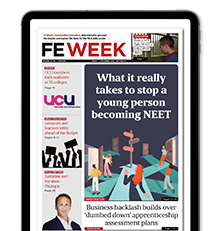A personalised experience is the way to win over this emerging group of learners, writes Sali Midjek-Conway
It’s more important than ever for FE colleges to think outside the traditional two-year post-16 pathway.
Higher education is now facing huge changes and challenges to the way it operates.
So what do we know about how higher education will look in the future?
University applicants are currently facing the stiffest competition in years, with deferrals, grade inflation, and tougher criteria.
A HEPI report published last year predicted a likely demand of up to 380,000 additional HE places by 2035.
Alongside this upsurge in demand, HE also faces a greater reliance on home students rather than international in future, due both to the UK leaving the EU and to the global pandemic.
What are the challenges faced by universities?
The global pandemic has changed the face of academic learning, with many universities now offering blended learning, mixing face-to-face lectures with digital teaching.
And while campus life is slowly returning, things look different to how they used to, with measures put in place to protect both students and staff. These appear likely to stay for the foreseeable.
The government’s “levelling up” agenda has also challenged universities to set new ambitious targets to support students by reducing dropout rates and improving progression.
What are the opportunities for FE colleges?
Policy changes mean that in future it may be more favourable for FE to support any additional demand for higher education.
We will see increased opportunities for HE in FE collaborations, including an increase in accredited degrees. We will also see a rise in non-traditional HE students, such as career changers, late bloomers and upskilling professionals.
We will see a rise in career changers, late bloomers and upskilling professionals
There are two elements to this: attracting a wider variety of HE students and ensuring the infrastructure can retain and support them towards successful outcomes.
According to a recent survey by YouthSight, 73 per cent of prospective students have already chosen their subject by August. But most (74 per cent) are yet to choose their university at that point – so there is everything to play for.
1. Consider your brand purpose
Are you offering what your HE market needs? And does your HE offering reflect your core values – in other words, are you playing to your strengths and offering what you’re best at?
Identifying what is distinctive in what you offer, compared to other colleges, will help you establish the wider and deeper value you offer to HE students, beyond the value of the fees.
2. Keep in mind the overall student experience
A distinctive student experience is a “sticky” campus – one that encourages students to stay beyond their classes and creates a community feel and a sense of belonging.
Consider the standard of the facilities, the overall look and feel of the campus. What work-life balance opportunities are on offer?
3. Encourage a democratic learning environment
Today’s students enjoy having a personalised experience, so maximise your current student data to enhance this and convert in-college progression. Another consideration is offering a co-authored HE curriculum, in which student feedback is part of the design.
4. Improve your internal communications
The challenges on the ground are often around infrastructure, staff engagement and buy-in. So develop an engagement strategy and aim to ensure staff understand HE in FE and the opportunities it presents for development, promotion and growth – both professionally and for the college’s future.
5. Pivot your messaging
Depending on your provision, make a change to promote the overall 16-to-21 journey. Create a compelling story – highlight what’s important to your target audience which encourages buy-in, such as convenience, progression in one place, employment destinations.
Gather testimonials and make use of HE champions, encouraging adult students to continue in education.
6. Lobby for better curriculum planning
Finally, gather and share data on student course enquiries and missed income opportunities to encourage your senior management to engage with the opportunities HE presents – if prioritised.
In today’s education climate the focus for colleges is on student experience, particularly when it comes to HE in FE.
If you can adopt even some of the above, it will be the beginning of offering a much more competitive proposition to an emerging group of discerning students.







Your thoughts